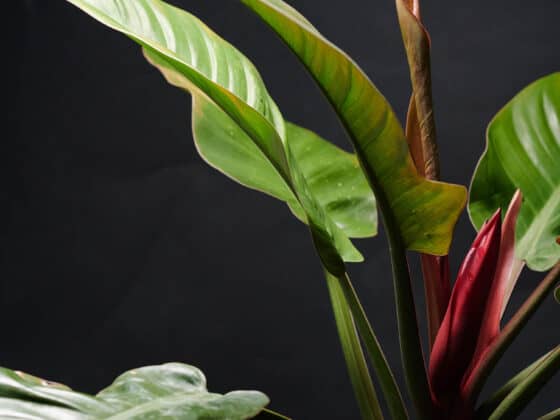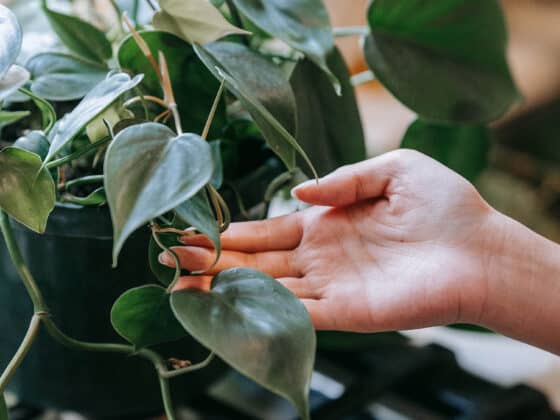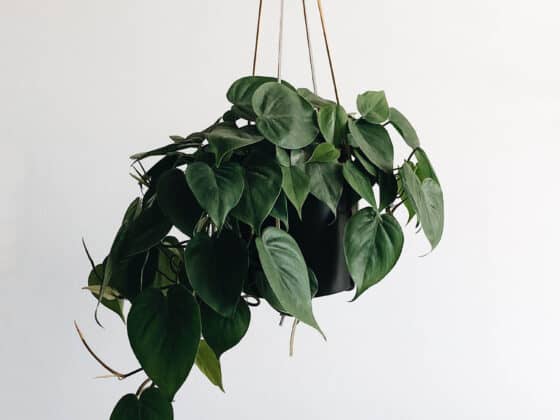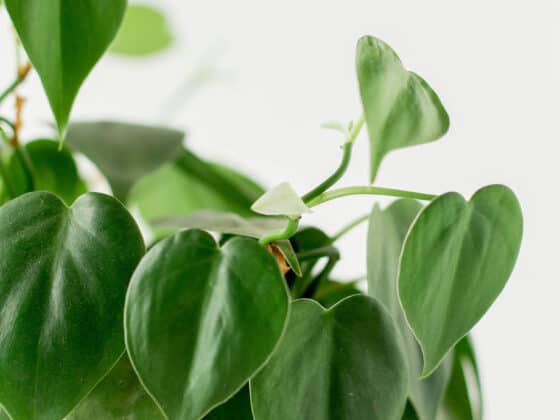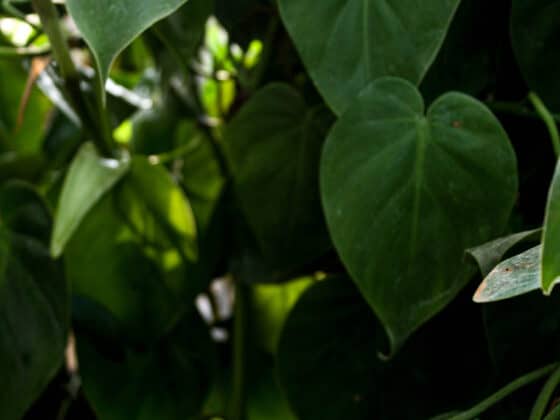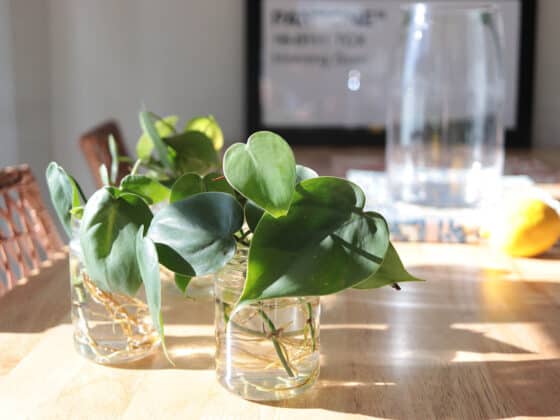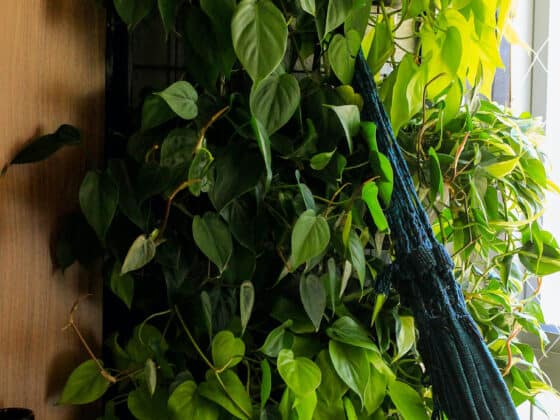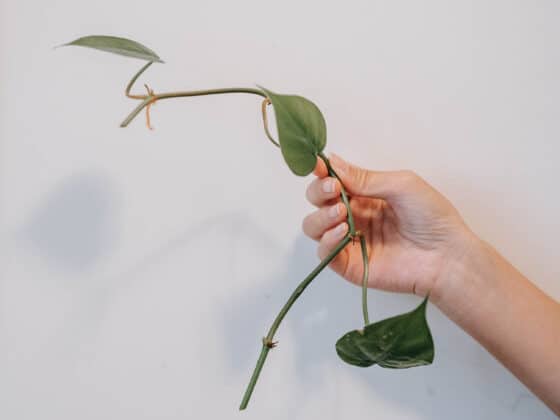Philodendrons have remained a popular type of houseplant because of their relatively easy care requirements and ability to produce lots of leafy growth in various colors and patterns. However, you may have noticed that your own Philodendron is looking a bit sparse or leggy. Why, you ask? It might be time to do some pruning.
Vining Philodendrons definitely benefit from occasional pruning. By cutting back longer vines, you can promote healthier, bushier growth with shorter internodes, giving your plant a fuller look and better shape.
As your Philodendron puts out more and more growth, the vines tend to produce longer and longer spaces between leaves, giving your plant a stretched out, leggy appearance. By occasionally clipping back even the very longest vines, you are directing the plant to produce stems that can support the new growth of tightly stacked leaves.
In this article, we’ll go over what to look for when deciding when to prune back a Philodendron and the steps you need to take to successfully cut back the plant in order to keep it as healthy and happy as possible.
A Quick Note on Self-Heading (Non-Trailing) Philodendrons
This article focuses on how to prune back trailing varieties of Philodendrons and doesn’t spend much time talking about the self-heading types. This is because those varieties of the genus do not really need pruning maintenance.
Self-heading (or “arborescent”) varieties form a thick, tree-like, upright stem with much larger leaves, often attached on long petioles. These leaves stack so close together that the stem is often completely hidden beneath the petiole sheath. As the plant grows, the main stem will continue to grow longer, and you may even begin to see aerial roots reaching out for things to grab onto for support.
However, because of how the plant is structured, there is really no place to prune back to control for size. The most you really need to do is be aware that older leaves will sometimes wilt and die back. You can prune any old, yellowed, or damaged leaves by cutting them back as close to the stem as possible.
Some types of self-heading Philodendrons may eventually produce pups, or small new stems forming out of the topsoil. If you find yourself in a situation where your very large Philodendron has produced these pups, you can remove them from the soil and plant them on their own to start new, smaller versions of your mother plant.
In most cases, trying to prune back a larger self-heading Philodendron to control for size will result in a severed stem that won’t be able to produce new growth, so it’s best to leave the plant to its own devices.
What to Do with an Overgrown Philodendron
The great thing about vining Philodendrons is that they can produce a lot of new growth rather quickly. This is often why we have them around our home, on high shelves, or in hanging pots. A cascade of beautiful leaves trailing down a bookcase is a sight to behold.
However, the downside to this is that, as Philodendrons push out these long vines, a lot of energy is used in the process, leaving little to produce tightly stacked leaves along the way. The result is a long vine with ever-increasing internodes as you follow it toward the end. Very quickly, your once bushy and full-looking Philodendron ends up looking scraggly and unhealthy. So, what can you do about it?
The good news is that this condition is easily fixed by regularly pruning your plant. Philodendrons actually thrive when exposed to occasional pruning, as it redirects energy back into the nodes, where new vining stems can emerge from.
As a result, these new stems start putting out closely stacked leaves as the vine is just starting to get established, keeping the plant looking fuller. Eventually, those new stems will also begin to elongate quickly and start to look sparse, but that’s okay. That just means they are ready for another trim.
By regularly incorporating maintenance pruning into your care regimen, you can keep your vining Philodendrons looking beautifully bushy and tidy.
When is the Best Time to Prune a Philodendron?
When you are pruning your houseplants, you want to pay close attention to the time of year or where your plant is in its growing season. This is because, for some plants, pruning takes a big toll, and they need enough time and energy to repair and recover.
Luckily, Philodendrons aren’t particularly picky about when or how often you prune them back. These are pretty resilient plants, so almost anytime you see a vine that needs trimming, you can go ahead and just take care of it right then and there. In general, feel free to prune at any point it seems necessary. For my plants, I like to stagger my pruning so that I only clip back a couple of vines at a time and separate my pruning session by several weeks. This achieves a few things.
First, the amount of stress the plant experiences at one time is lessened, setting it up for a faster recovery. Second, I can maintain the appearance of a bigger plant for longer. By staggering my cuts, I always seem to have a few longer vines that trail nicely. As one or two get clipped back, the others continue to grow long, until it is their turn to get pruned.
In some cases, a Philodendron may have grown into a tangle of long, bare vines. The best course of action is to prune everything back close to the crown of the plant to allow it to restart with new, compact growth.
If you find yourself in this situation, it might be a good idea to wait until the Spring to do this more severe prune. This allows an entire growing season for the plant to recover from the stress of the prune, and there will be ample time for new vines to grow back before the plant slows down in the dormant season.
How to Prune Back Your Philodendron
Once you’ve identified that your Philodendron may benefit from a trim, it’s time to put the pruning shears to work. However, knowing exactly where to make the cuts will ensure that your plant can quickly recover and start producing new stems and leaves.
First, you’ll want to make sure you have a sharp, clean set of garden shears or scissors to make your cuts. You want them sharp to minimize the damage done when making the cuts so that the plant can heal quickly. You need them clean to avoid exposing your plant to bacteria or viruses that can infect them through the cuts you are making.
You will want to identify how far up the vine you want to make your cut. Follow a vine back up towards the crown of the plant and look for the spot where long internodes give way to well-stacked foliage. This is a great spot to prune to, as it maintains the healthiest portion of the vine and keeps your plant looking full.
Once a cut is made, the plant will release hormones that will activate the node below the cut line to produce new growth. From that node, a new stem will emerge and eventually grow into a longer vine full of leaves.
This means you need to be sure you’ve identified exactly which node you are planning to make your cut next to. In most cases, there will be a leaf protruding from the stem anywhere a node is, so you can aim to make the cut just above a leaf. However, sometimes leaves fall off, so you can also look for a brown ridge line that goes around the stem as an indicator of a node.

Make your cut about a quarter inch above the node you’ve selected. This is close enough that the node will likely be activated to produce new growth without preserving a long section of internode that will eventually shrivel away, but far enough away that your shears don’t do any damage to the node you are hoping to activate.
Make clean, level cuts to the vine and avoid any smashing, crushing, or mashing of any plant tissue. Your Philodendron will recover easily from a well-made cut but can falter when trying to repair a mess of damaged tissue.
Once you make all your cuts, care for your plant as usual, making sure it has proper water and plenty of bright, indirect light. Within several weeks, you’ll start to see new growth emerging from just below your pruning cuts that will eventually create new vining stems that can produce tight, healthy leaf growth.
Propagate Your Cuttings
Those vines you just removed can be easily rooted out in water and potted into their own containers to start new plants for your home. Or, if your newly-pruned Philodendron is looking a little sparse at the crown of the plant, these rooted cuttings can also be transplanted back into the same pot to help fill in the bald spot.
Create stem cuttings by trimming about four inches off the end of each pruned vine. Be sure to make your cut just below a node this time to allow roots to emerge. Place these cuttings in a small jar or glass filled with clean water and set on a window sill with lots of bright, indirect light.
Over several weeks, you will see new roots emerging from the submerged nodes on the cutting. When the roots are several inches long, transplant the cuttings either back into their original pot or group them together in a new pot to make a new vining Philodendron for your home.
Here you can learn more about how to root and propagate a Philodendron stem or leaf cutting.
Should You Ever Trim Back Philodendron Leaves?
On occasion, your Philodendron may have a leaf or two that look yellowed, damaged, or wilted. This is because these plants, although often protected within the confines of our homes, are still subjected to situations and elements that are detrimental to their health.
Oftentimes, the appearance of one or two sickly leaves is nothing to be concerned about. Older leaves tend to shrivel away and die back as the plant ages. Perhaps your plant got a bit too much direct sunlight, and a few leaves got scorched. Maybe you accidentally overwatered your plant, and it’s struggling to recover.
Regardless, it is almost always best to prune away the questionable leaf in situations like these. Once a leaf has been damaged, they rarely fully recover, so it is best to remove it to allow the plant to redirect its energy into producing new growth. You can do this any time you notice a sick or damaged leaf. Grab your sharp, clean shears and take the leaf back as close to the stem as you can.
However, as a reminder, if you notice several leaves that are damaged or yellowing, you may have an underlying health issue you need to address before it spreads to other parts of the plant. Yellowing leaves often indicate overwatering issues, usually starting near the base of the plant, and can lead to serious conditions like root rot.
When monitoring leaves and considering removal, just be sure you aren’t overlooking a systemic health issue.
Can You Ever Trim Back Philodendron Roots?
Philodendrons are fairly good growers, and they tend to have rather strong root systems to help support that growth, so they can very easily outgrow the containers they are planted in. When this happens, the roots will continue to grow, but they begin wrapping around the root ball without anywhere to go, creating a tightly wound mess. This can make watering and moisture management difficult to control and can end up hindering important functions like nutrient uptake and gas exchange.
The solution is to repot your Philodendron into a bigger container. This will allow more room for the root system to grow properly, while efficiently supporting the plant’s needs. But, what can you do if the root ball is a tight, tangled jumble?
The next time you repot your Philodendron, you can trim back the root system to allow for proper growth and avoid root binding. The goal is to maintain as much of the root system as possible while removing any problems like tightly winding roots or anything that looks rotten or unhealthy.
The best way to do this is to remove the plant from its container and wash away as much soil as you can so you have a clear view of the entire root system. Identify any roots that have wrapped themselves around the root ball tightly. Gently clip those roots away to expose the rest of the system beneath.
Be conservative and take your time. You want to eliminate problem roots, but make sure you aren’t removing all the larger tap roots that supply the plant. Typically, you’ll find that one or two roots have wound around the pot several times, so removing just those can make a huge difference.
Once that’s done, you can also scan the root ball for anything that looks black, brown, or mushy. These are rotten roots that won’t ever recover or function properly, and worse, could spread disease to other parts of the plant. Clip these out as completely as you can. Once you’ve finished making your cuts, transplant your Philodendron to its new container, and be sure to use fresh potting soil to fill around and secure the plant. Water it well.
Care for your plant as usual, but keep a close eye on it. Because you trimmed the root system back and repotted it, your Philodendron might be experiencing a little bit of shock. That’s okay! These plants are resilient. It may take several weeks before it becomes established in its new home, and you’ll want to diagnose and correct any health issues that may crop up during that time.
Putting It All Together
Philodendrons are known for their beautiful cascading growth habit, but over time, they can tend to look a little scraggly and sparse. Regular pruning of longer vines is the key to keeping your plant producing healthy, tightly stacked leaf nodes to give it a thicker, fuller appearance.
Feel free to trim back your Philodendron whenever you feel a vine isn’t producing attractive growth, or try staggering your pruning sessions so each vine eventually gets trimmed while maintaining a longer appearance overall. It may seem a bit counterintuitive, but just know that a few well-timed trims will keep your Philodendrons looking bushier and healthier than ever!







